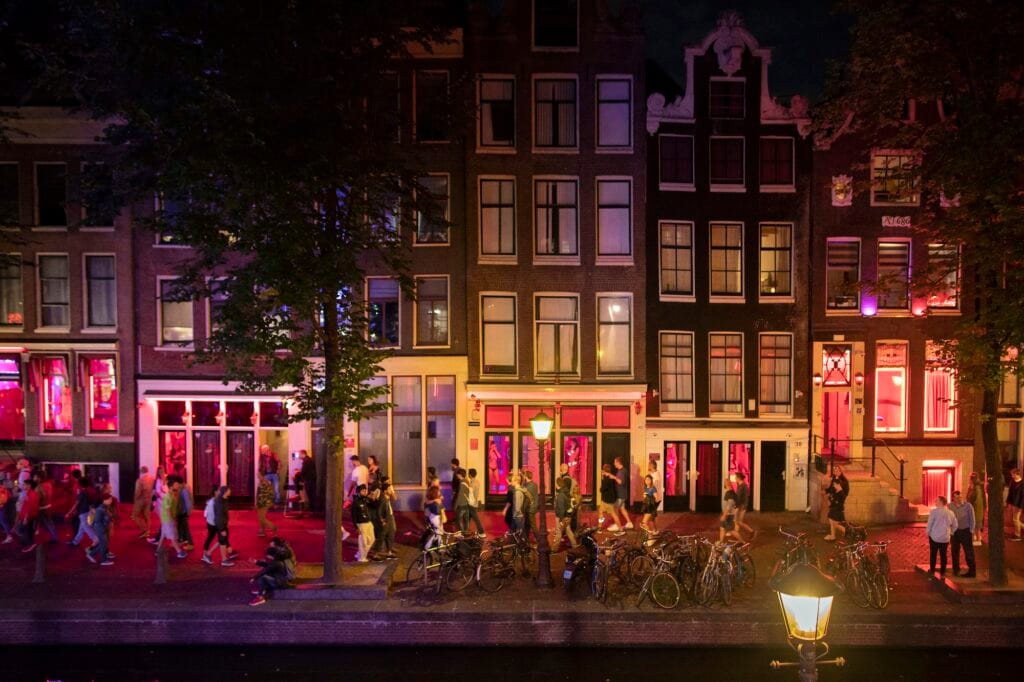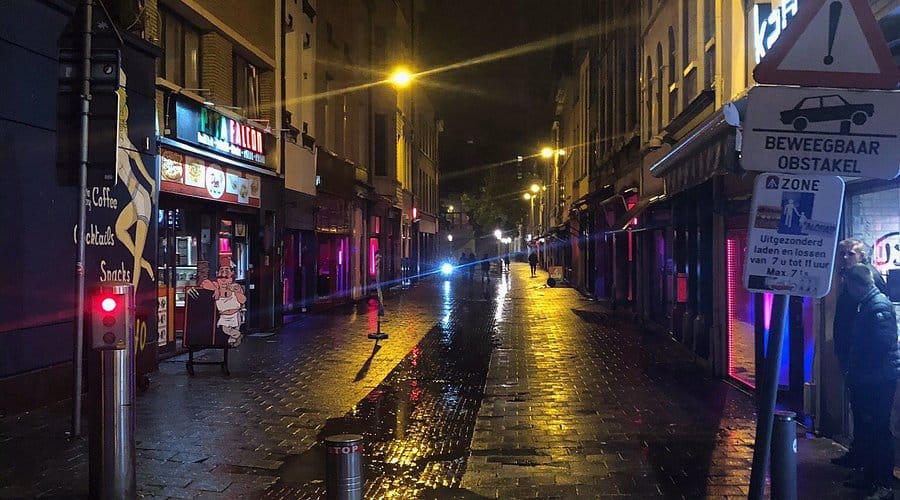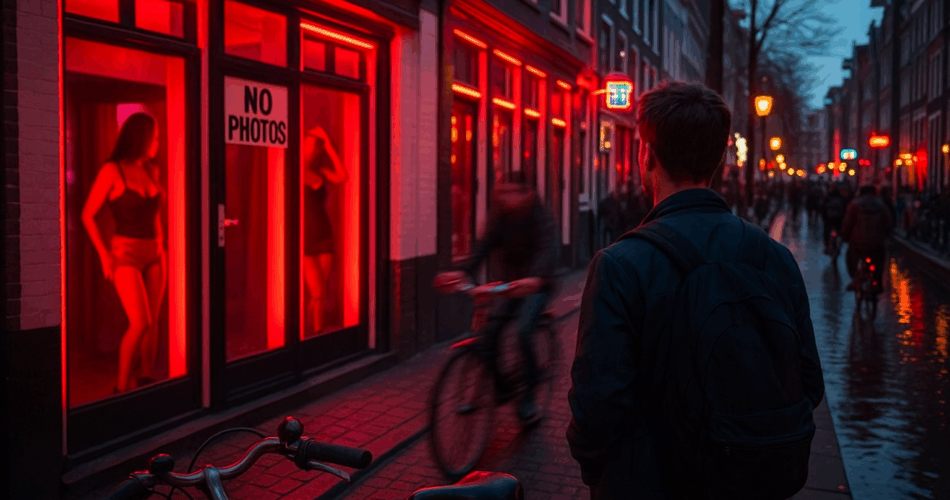Visiting Amsterdam and nervous about taking pictures? You are not alone. Photography in the red light district can feel confusing because the rules are strict and signs are not always clear. This guide explains what is allowed, what is not, why those rules exist, and how to come home with great, legal images without stress. It focuses on respect, safety, and confidence so you can enjoy the neighborhood and still tell a visual story. In short, this is how to handle photography in the red light district the right way.

Why There Are Rules
Dignity, Safety, and Workplaces
Windows and doorways in De Wallen are workspaces. Sex workers have a right to privacy and safety. Unwanted photos can be used to harass, track, or shame. That is the core reason photography in the red light district is limited near windows and entrances. Respecting that boundary keeps the area safer for everyone, including visitors.
Where Photos Are Not Allowed
No-Photo Zones You Should Recognize (and why)
For photography in the red light district, assume any place a sex worker could be identified is off-limits. That means:
Windows, doorways, and lit alleys
Windows and doors of workspaces are private workplaces. Pointing a phone or camera toward them—even for “just a second”—is treated as a violation.
Narrow alleys lined with red-lit windows (for example, the lanes between Oudezijds Achterburgwal and Oudezijds Voorburgwal) are effectively no-photo corridors. Aimed lenses here draw immediate warnings from staff or security.
Entrances to venues
Club, peep-show, and private house entrances are also no-photo areas. Guests and staff deserve the same privacy as workers at the windows.
Reflections, long lenses, and “from far away”
If a person can be recognized in a reflection (shop glass, canal water, polished tiles), it still counts.
Using a telephoto lens from a bridge to capture a window two streets away is treated the same as standing in front of it. Distance does not change the rule.
“Public street, my rights?” misconception
You are on public streets, but the city and venue operators enforce no-photo policies around sex-work windows for privacy and safety. Think of it like walking through a hospital or school: public sidewalk, private activity. Respect wins.
Flash, tripods, and drones
Flash can accidentally light a window or doorway; do not use it in De Wallen.
Tripods and light stands can be blocked by police or wardens as obstructions in crowded alleys.
Drones are a hard no: central Amsterdam is restricted airspace, and flying here risks confiscation and fines.
What enforcement looks like
You may be warned, asked to delete an image, or reported to police. Staff or marshals can position themselves to block your lens. None of this is negotiable; lower the camera and move on.
Bottom line: if a shot could show a worker, a client, or a venue entrance, it is not permitted. Treat these areas like any other private workplace and keep your camera down. That is the safest, most respectful approach to photography in the red light district.

How To Take Photos In No-Photo Zones Without Getting Caught
Use Ray Ban Meta Glasses
Ray Ban Meta Glasses are a great way to take photos and videos without getting caught. Although they are getting easier to recognize, this is going to be your best bet to take photos and video without getting caught.
What Happens If You Ignore the Rules
Warnings, Fines, and a Ruined Night
Staff may block your shot, ask you to stop, or call police. You can be fined, told to delete images, or escorted away. None of that is worth a risky photo. Keep photography in the red light district on the right side of the line and your evening will be easier, safer, and more fun.
Gear and Wearables
What Works, What Does Not
You do not need a huge kit. A phone or small camera with good low-light performance, a wrist or cross-body strap for security, and a simple rain cover for showers are enough. Action cameras or body-mounted devices are allowed only in public street areas where photos are legal, and you must keep them pointed away from windows. Hidden cameras or covert wearables are not acceptable and do not fit the spirit of photography in the red light district.

How To Shoot Great Images Legally
Composition, Angles, and Light
Go wide and indirect. Compose cityscapes, reflections on the canal, or textured close-ups of brick and wood. Change your angle so windows are never in frame: tilt down toward water, up toward rooftops, or across to street art. Work with the light you have. At night, use your phone’s night mode or steady your camera on a bridge rail for a long exposure of bike lights and boats. If you want portraits, step outside the red-light alleys and politely ask a shop owner or bartender for permission. Ethical choices turn photography in the red light district into a creative challenge rather than a rule to beat.
Day vs. Night
Different Looks, Same Boundaries
Photography in the red light district changes character with the clock, but the rules stay the same: never point a lens at windows, doorways, or anyone who could be identified. By day, the neighborhood is softer and slower, which makes it easier to frame bridges, church façades, and narrow canals without people becoming the subject. Natural light reveals texture in old brick and cobblestones, and you can tilt the camera upward to gables or downward to water and railings to keep private spaces out of view. At blue hour, neon begins to glow and reflections bloom across the canals. Night adds drama and color, yet the same boundaries apply. The safest approach is to work from wider streets and larger bridges, steady the camera on a railing, and build scenes around light, water, and sky. A simple long exposure across a canal can deliver the classic night look—streaks of bikes and boats, glossy pavement, and bright signs—while keeping photography in the red light district lawful and respectful.
Weather and Season
Rain can be your friend. A light shower turns every surface into a mirror, giving you cinematic reflections without changing where you can shoot. Winter brings early sunsets and long blue hours; dress warm so you can wait for the right light. Summer offers late golden light on rooflines and plenty of time to explore angles that avoid windows. In every season, the same idea holds: aim for mood and place, not faces.

Posting and Sharing
Check Before You Upload
Responsible photography in the red light district continues after you leave the street. Before you post, scan each frame for anything that could reveal a person’s identity, including reflections in shop glass or canal water. If a worker, client, or staff member could be recognized, do not publish the image. Choose a different frame, crop tighter to architecture, or blur the background so privacy is protected. It also helps to turn off location tagging and remove metadata when you share. A short note in your caption about respecting local rules and consent shows your followers how to enjoy the neighborhood without crossing lines and teaches others to treat the area with care.
If Someone Objects
De-escalate and Move On
Even careful photographers can make a mistake. If someone signals “no photos,” lower the camera at once, say sorry, and step away. A simple “Sorry, geen foto’s” in Dutch is enough. Do not argue, do not keep filming the moment, and do not review frames unless asked. Walk to a wider canal or a nearby square, reset, and rebuild your scene around buildings, bridges, and water. Calm, quick respect protects your evening and keeps photography in the red light district pleasant for you and for the people who live and work there.
Safe Ways To Capture the “Inside” Vibe
Legal Alternatives With Character
If you want the atmosphere of interiors without entering no-photo alleys, choose spaces that welcome cameras. Many museums and exhibitions allow non-flash images in marked areas, and their lighting, textures, and typography echo the city’s story without risking anyone’s privacy. Public buildings and some canal houses permit photos in lobbies or halls; always check signs at the door and avoid capturing people’s faces. Guided history walks can point you to photo-friendly viewpoints and explain exactly where photography in the red light district is appropriate. Cozy cafés and traditional brown bars also offer rich detail—wood, copper, glass, and warm lamps—if you ask staff for permission first and keep patrons out of frame. Another strong option is a canal cruise at dusk: from the water you can frame bridges, gables, and reflections in comfort, with zero chance of pointing a lens at a no-photo window. These choices keep the mood you came for while honoring the privacy that makes the neighborhood work.
Respect Is the Shortcut to Great Photos
You can create striking images without pointing a lens at anyone’s workplace. Focus on canals, bridges, neon, and the layered architecture. Ask for permission outside the red-light alleys, and share only what keeps people safe. When you travel with empathy, photography in the red light district becomes relaxed, creative, and memorable—for you and for the community that hosts you.
